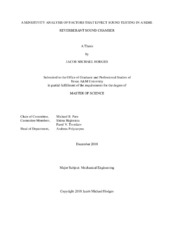A Sensitivity Analysis of Factors That Effect Testing in a Semireverberant Sound Chamber
Abstract
The need to understand and control factors influencing sound testing of range hood and bathroom ventilation fans in a semi-reverberant sound chamber is of great importance to both certification bodies, such as the Home Ventilation Institute, and private designers of household demand-controlled ventilation fans. The use of sones as a unit for fan noise is superior to decibels as it captures the human perceived sound loudness. The maintenance and improvement of procedures requires consideration of many possible sound testing influences, such as weather influences on the Resonant Sound Source (RSS) used during testing, the impact of the RSS on final sone values, and various sources of variability as evaluated by a gauge repeatability and reproducibility study.
Data taken for the investigation of possible correlations between measured RSS with weather spanned a period of four quarters starting in the fourth quarter of 2017 and was made up of ten randomly selected sound tests per quarter performed at RELLIS Energy Efficiency Laboratory (REEL).
Also considered in this study was the effect the RSS has on final sone values. This was quantified by the ratio of the room characteristic ratio to fan sound power levels. This study identified key conditions that cause the RSS to contribute maximally to sones. The role of the critical frequency band for a given sound test was examined by correlating the room characteristic ratio with the frequency of the critical band over a sample of 40 tests per RSS type, showing a -52% correlation coefficient relation.
The gauge repeatability and reproducibility analysis showed the total gauge repeatability and reproducibility (GR&R) of the entire sound measurement system as a percent of the total
standard deviation was found to be 5.57%, which is less than the commonly accepted value of 10% for most measurement systems. This GR&R value was used for comparison to recent variation due to requalification efforts involving changing microphone type (free field vs. diffuse), showing that the variance of requalification for new microphone types is less than the normal expected variance of the measurement system due factors such as changing operators, mounting and dismounting, etc.
Citation
Hodges, Jacob Michael (2018). A Sensitivity Analysis of Factors That Effect Testing in a Semireverberant Sound Chamber. Master's thesis, Texas A&M University. Available electronically from https : / /hdl .handle .net /1969 .1 /192056.


